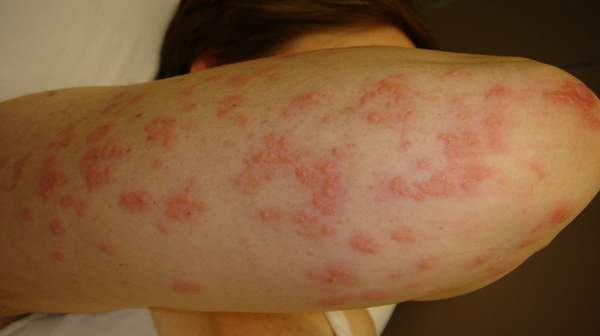What's in this article?
Dermatitis herpetiformis (DH), or Duhring’s disease, is a chronic blistering skin condition, characterised by blisters filled with a watery fluid. Despite its name, DH is neither related to nor caused by herpes virus: the name means that it is a skin inflammation having an appearance similar to herpes.
DH was first described by Louis Adolphus Duhring in 1884. A connection between DH and coeliac disease was recognised in 1967, although the exact causal mechanism is not known. DH is a specific manifestation of coeliac disease.
The age of onset is usually about 15-40, but DH can also affect children and the elderly. Men and women are equally affected. Estimates of DH prevalence vary from 1 in 400 to 1 in 10000. It is most common in patients of northern European/northern Indian ancestry, and is associated with the HLA-DQ2 haplotype along with coeliac disease and gluten sensitivity.
Who gets Dermatitis Herpetiformis?
- DH predominantly affects Caucasians aged 15–40 years, but may occur in those younger or older and in other races.
- There is a 2:1 male-to-female ratio.
- More females under the age of 20 are affected than males.
- There is a genetic predisposition and association with human leukocyte antigens (HLAs) DQ2 and DQ8.
- Some patients have a personal or family history of other autoimmune disorders including thyroid disease, pernicious anaemia, type 1 diabetes, vitiligo, Addison disease and alopecia areata.
Causes of Dermatitis Herpetiformis
Dermatitis herpetiformis usually begins in people age 20 and older. Children can sometimes be affected. It is seen in both men and women.
The exact cause is unknown. It is an autoimmune disorder. There is a strong link between dermatitis herpetiformis and celiac disease. Celiac disease is an autoimmune disorder that causes inflammation in the small intestine from eating gluten. People with dermatitis herpetiformis also have a sensitivity to gluten, which causes the skin rash. About 25% of people with celiac disease also have dermatitis herpetiformis.
Symptoms of Dermatitis Herpetiformis?
DH is one of the itchiest rashes possible. Common locations of the rash include:
- elbows
- knees
- lower back
- hairline
- back of the neck
- shoulders
- buttocks
- scalp
The rash is usually the same size and shape on both sides of the body and often comes and goes.
Before a full outbreak of the rash, you may feel the skin in a rash-prone area burn or itch. Bumps that look like pimples filled with clear liquid start to form. These are quickly scratched off. The bumps heal within a few days and leave a purple mark that lasts for weeks. But new bumps continue to form as old ones heal. This process can continue for years, or it can go into remission and then return.
Treatment for Dermatitis Herpetiformis
An antibiotic called dapsone is very effective.
A strict gluten-free diet will also be recommended to help control the disease. Sticking to this diet may eliminate the need for medicines and prevent later complications.
Drugs that supress the immune system may be used, but are less effective.
Possible Complications
Thyroid disease may be found in many people with dermatitis herpetiformis. People with dermatitis herpetiformis are also more likely to develop certain cancers of the intestines. The drugs used to treat dermatitis herpetiformis can also have side effects. Blood tests will be needed to check the levels of these drugs in the body.





